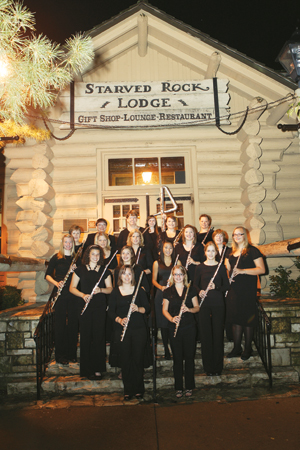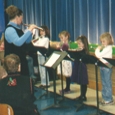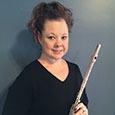 When I was in high school, I played in my first flute choir. We played Tribute to Richard Rodgers for an IHSA solo and ensemble contest. I was hooked. Playing with the flute choir allowed me to easily hear myself in the small ensemble and learn to blend with the colors of the other instruments in the flute family.
When I was in high school, I played in my first flute choir. We played Tribute to Richard Rodgers for an IHSA solo and ensemble contest. I was hooked. Playing with the flute choir allowed me to easily hear myself in the small ensemble and learn to blend with the colors of the other instruments in the flute family.
As I began my career as a studio owner and teacher in 1990, I wanted to enhance lessons with ensemble classes but had not quite figured out how to arrange the ensemble classes into my weekly schedule. As the school year came to a close, I realized that many of my students would not take private lessons over the summer. I worried they would lose the skills they had worked so hard to attain during the school year.
I decided to offer a weekly summer flute choir, so students would continue to play their flutes during the summer. The students enjoyed the experience so much that they asked to have flute choir year around.
What started as an ensemble of flutists from area junior high schools eventually evolved into a flute choir program with five or six flute choirs, each for a different age and ability level. My hope was that not only would the students improve musically, but flutists from all the schools in the area would become colleagues and create a healthy relationship between the schools’ music programs.
Tuition: To Pay or Not to Pay
My studio curriculum includes private lessons, group technique classes, and an optional flute choir class. There is a small additional fee to participate in the flute choir. I have found if I do not put a nominal fee for the flute choir class, the class is not viewed as having value. I have a large studio and almost everyone participates in flute choir.
Performance
Each December and May we present a studio recital. The program features flutists playing solos and flute choir performances. Sometimes there are students who are not ready for a solo, but in the safety net of a flute choir can enjoy the benefits of a public performance. The experience and confidence they gain eventually enables them to perform alone.
The flute ensemble comprised of six and seven year olds is often one of the highlights of the recital. These young flutists perform like professionals. I emphasize stage presence and recital etiquette right from the start. Topics include how to walk on stage, adjust music, begin together, watch each other, playing accelerandos and ritards, the cut-off for the final note, bowing and acknowledging the audience. Another benefit comes from the younger students watching the older ensembles. When flutists graduate from high school, they are offered the opportunity to perform a solo with the flute choir.
The flute choirs have an active public performance schedule in addition to the studio recitals. Our traditions include Christmas caroling at Starved Rock Lodge (one of the largest state parks in Illinois) and a spring concert at the Hegeler Carus Mansion (a historical landmark) in addition to performances for church services, private parties, and weddings. These make the flute choirs a visible asset to the community. The top flute choir has performed at the 37th Annual Principal Conference in Peoria and twice at the Chicago Flute Club Flute Festival.
Continued Benefits
Since the flute choir program has been going for a while, I now have an adult flute choir made up of former students who played flute in high school and college. Now after starting a career and a family, they are able to return to flute playing as a hobby. Many of these flutists are parents of my younger students.
The Essentials
Should a flute choir sit or stand? I prefer having the flute choir stand for rehearsals and performances. This encourages the development of good alignment and breathing habits. Most rehearsals are 50 to 75 minutes long. If you train flutists to stand properly from a young age, they accept that as how to play in a flute choir. No one complains.
We rehearse at my studio. This is where I also keep the large flutes (alto, bass, and contra) and several file cabinets of music. My students enjoy learning and performing music from all genres – everything from classical transcriptions to a Beatles medley. Currently one flute choir is working on a Lady Gaga medley for an upcoming performance. The flute choir usually plays without a conductor; this offers a true chamber music experience as flutists listen and watch their colleagues. Concert dress varies according to the venue from concert black to studio tee-shirts.
Fundraisers
Several years ago we started a scholarship fund to provide financial assistance to flute students attending flute camps. Through the years we have made and sold CDs on which each student in the studio performs. This project has taught me a great deal about obtaining mechanical licenses, designing covers, and the duplication process. This year the theme for the studio CD is Americana/Patriotic repertoire.
We have also raised funds to sponsor guest artists in our community. We host an annual Flute Day and a Visiting Artist series. Guest artists have included Rhonda Larson, Greg Pattillo, Patricia George, Steve Kujala, Jim Walker, Mike Garson, Shanna Gutierrez, Ali Ryerson, and flute professors from the various Illinois universities. Besides providing scholarships, these funds have helped the studio purchase a contrabass flute.
The Next Step
Fourteen years ago I added a Summer Flute Retreat. The weeklong masterclass program is housed at a local community college. My former university flute professor, Gerald Carey, teaches alongside with former student Rachel Bailey and colleague Ellen Huntington. While this program was organized primarily for my students, we now have students from other cities in Illinois, Wisconsin, Indiana, Mississippi, California, and New Jersey attending. Since the community college does not have dorm facilities, my students host the out-of-town students. Many of these flutists have become life-long friends.
You Can Do It
I highly recommend adding a flute choir or ensemble program to your studio program as the benefits are immeasurable. Students not only develop musically but develop life-long friendships. A whole generation of students in my community has literally grown up together sharing their love of and passion for the flute. They support one another; if one student is having trouble with a passage, another will say, “let’s figure out how to make that easier for you.” It is truly a remarkable situation.






